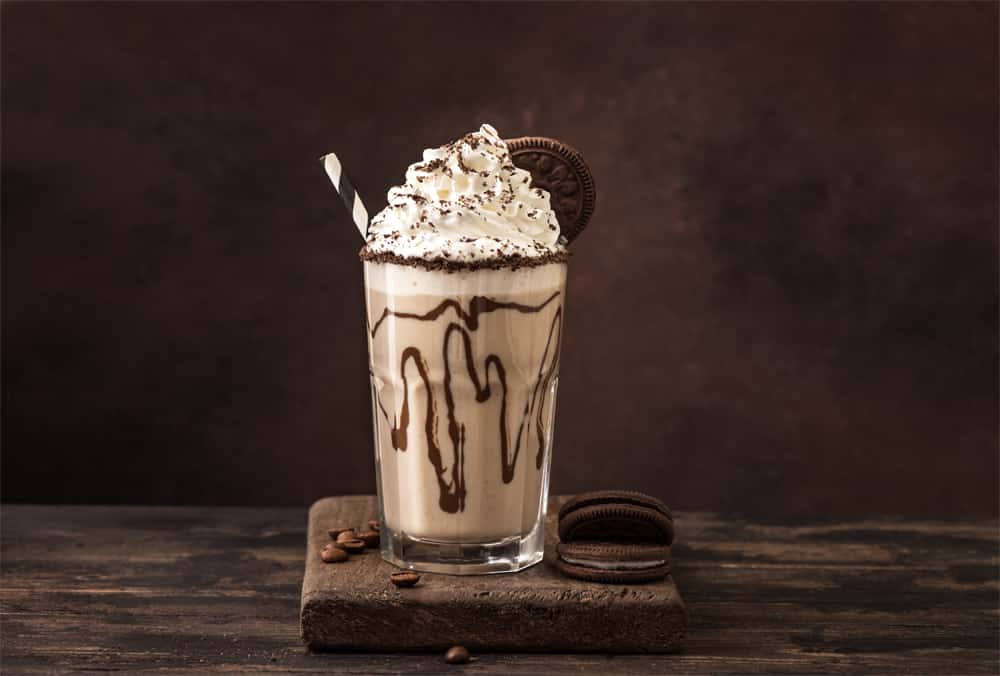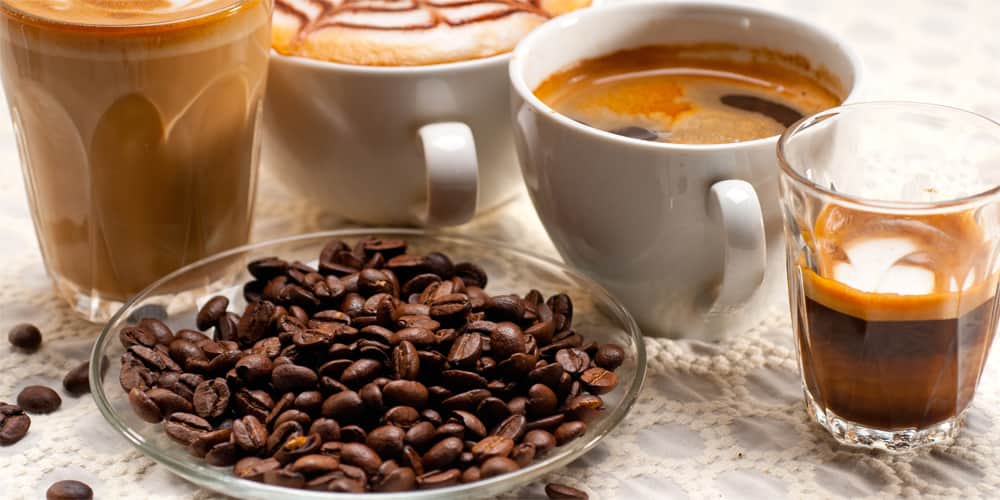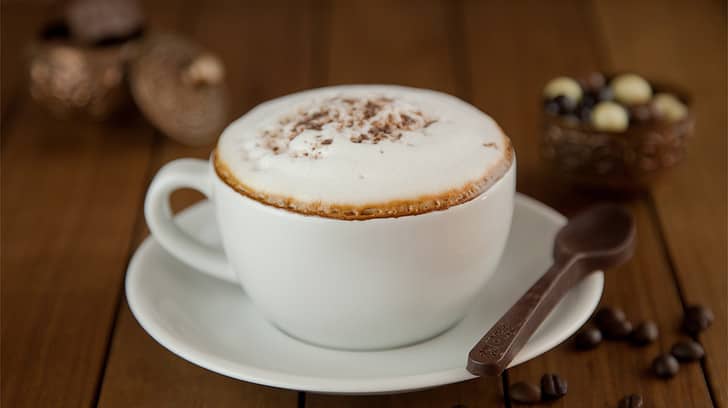Frappuccino vs Latte: a coffee battle for the ages, right?
Well, maybe not so much a battle. However, these two different types of coffee-based drinks do come up a lot in the occasional coffee debate. That debate usually boils down to what’s the difference between them, if any.
Before anyone asks if there are any differences, yes, there are differences. Big ones. We’ll get into what those differences are in more detail below. Let’s say briefly, though, that although they’re coffee drinks, they’re both served differently, have some different ingredients, and are always separate menu items on coffee menus, especially Frappuccinos.
But for now, let’s highlight a few key similarities. One, as already mentioned, they share coffee as their key ingredient. Two, they both have milk in them (although not in the same form). Three, they’re both very popular with coffee consumers.
Now that those similarities are out of the way, let’s get into the gritty details of how these two popular coffee drinks are different and why knowing those differences is important for anyone interested in coffee beverages and who wants to know what you’re ordering at the local bistro.
What is a Frappuccino?

It’s one thing to know what a Frappuccino is. It’s another thing to know its history.
In short, a Frappuccino makes up a line of coffee-based drinks that usually consists of:
- A coffee or even an espresso base
- Milk
- Ice
- Other flavorings like spices, syrups, or sweet powders like confectioner’s sugar
- Whipped cream topper
That’s a Frappuccino in a nutshell. However, note that we said Frappuccinos make up a line of coffee-based drinks. That’s where knowing the history of the Frappuccino is important.
The Frappuccino was invented in 1992 in Cambridge, Massachusetts at a coffee shop called Coffee Connection. They took an existing drink recipe that included espresso, milk, and sugar and concocted a mixture that had a consistency more similar to a watered-down milkshake (only with coffee and blended ice).
The drink and the coffee shop became a hit. So much so, that when Starbucks acquired the shop in 1994, they also acquired the rights to the name Frappuccino. And in 1995, it became a main menu item at Starbucks worldwide.
So, one of the main differences between a Frappuccino and a latte, besides how they’re made and what they’re made of, is also the fact that Frappuccino, at least the name, is owned by Starbucks. That doesn’t mean you can’t get a similar drink in other places. They’ll have a different name, though. Probably something like a frappe, granita, or plain old frap.
What is a Latte?

The history of a latte, or cafe latte in its more traditional name form, isn’t as interesting as the Frappuccino when it comes to its impact on modern culture. After all, the Frappuccino is a relatively new drink compared to the latte. The latter has been around a while and doesn’t carry all the popular cultural notoriety of the Frappuccino.
That being said, the latte has been around a lot longer and you can get it in pretty much any coffee shop you visit. Its origins aren’t exactly clear, but it is an Italian coffee drink that became well-known probably in the 1800s in Europe when the espresso was invented. Cafe lattes were not new at the time, since they were a way of simply ordering coffee with milk. However, when milk became a more popular mix with espressos, the name “cafe latte” became more synonymous with that specific drink recipe.
It should be noted, however, there is no definitive date or name associated with the exact invention of the cafe latte, even though there are several claims as to when and where it became a popular menu item, especially in the US between the 1950s and 1980s.
Now that the history lesson is out of the way, we can answer what exactly a latte is made up of. Well, a cafe latte consists of:
- Hot espresso
- Steamed milk
- Foam topper
The Big Differences
The key takeaways as far as big differences between a Frappuccino and a latte are:
- Frappuccinos are mixed with ice and served cold, whereas lattes are usually served warm and include steamed milk and foam
- Frappuccinos are always sweeter and rely heavily on sugar and syrup to provide the creamy desert-like consistency it’s known for
- Frappuccinos, as a registered and owned “name,” belong to Starbucks
Also, Frappuccinos have less caffeine and tend to be served in plastic cups because of their cold nature.
Other Commonly Asked Questions
What’s The Difference Between A Latte And A Cappuccino?

Ah, now this might be the most interesting question because both a latte and a cappuccino share the same ingredients. As a reminder, those ingredients are:
- Hot espresso
- Steamed Milk
- Foam topper
Re-reading that list, you wouldn’t be wrong if you said, “Hey, that’s exactly how you described a latte.” The main difference between a latte and a cappuccino, though, is the ratio of the ingredients. A latte tends to have more steamed milk than espresso. It also usually has less foam. A cappuccino has more espresso than milk while having more foam.
The result is a latte will be creamier because of the higher milk content. A cappuccino will be more robust with a deeper coffee flavor tempered by more foam.
Both drinks can have sugar added, but neither will ever be as sweet as a Frappuccino.
What About An Iced Latte? Is That Different From A Frappucino?
Although an iced latte does have ice in it like a Frappucino, it is still not a Frappucino. Think of it more like a cold latte that doesn’t have foam.
Why Are Frappuccinos So Tasty?

Syrup and sugar and lots of it.
Are There Non-Coffee Frappuccinos?
Yes, Starbucks has often found a way to market various types of Frappuccinos without actual coffee in them. Examples include:
- Strawberry Frappuccino
- Vanilla Bean Frappuccino
- Double Chocolate Chip Frappuccino
Can You Order A Latte In Italy?
Yes. However, “latte” means milk in Italian, so if you go into a coffee shop and ask for a latte, you’re likely to get handed a glass of milk.
Also worth noting, a cafe latte is more of a traditional breakfast drink in Italy and is typically prepared at home. So, if you try to order one out in town, be prepared for confused looks if it’s not a menu item.
Lastly, a traditional Italian latte is usually mixed with hot espresso and heated milk without any foam. Also, sugar is up to the drinker, so don’t expect it to come with it already added.







